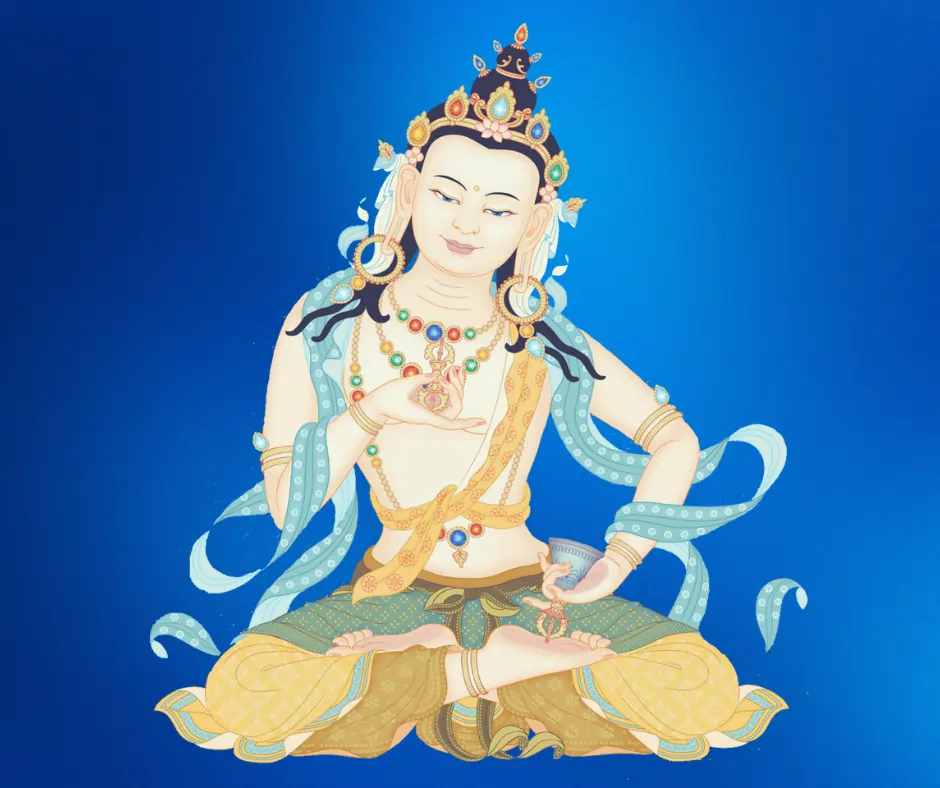Vajrasattva
Vajrasattva is a prominent figure in Bajracharya Buddhism, revered as the embodiment of purity, purification, and spiritual transformation. Often depicted as a white, radiant being, Vajrasattva symbolizes the power to cleanse negative karma and purify the mind and heart from past mistakes. In iconography, he is shown holding a vajra (thunderbolt) in his right hand, symbolizing indestructible power and skillful means, while his left hand holds a ga (गं in Newari), ghanta, bell, representing wisdom and the female principle. Together, these objects signify the union of compassion and wisdom, essential for the path to enlightenment. Vajrasattva is worshipped in almost all Bajracharya rituals.
What Is the 100-Syllable Vajrasattva Mantra?
The 100-syllable Vajrasattva mantra, also known as the शत्ताक्षर मन्त्र (Shattakshara Mantra) in Sanskrit, is chanted to purify the practitioner’s negative thoughts, actions, and karma. It calls upon Vajrasattva, the Buddha of purification, asking for his help in cleansing impurities and granting divine wisdom.
शत्ताक्षर मन्त्र in Sanskrit:
ॐ वज्रसत्व समय मनुपालय ॥
वज्रसत्वत्वेन प्रतिष्ठो ॥
दृढो मे भव ॥
सुतुष्यो मे भव ॥
सुपोष्यों मे भव ॥
अनुरक्तो मे भव ॥
सर्व सिद्धि मे प्रयच्छ ॥
सर्व कर्मसु च मे चित्त श्रियं कुरु ॥
हूँ हहहह हो भगवन् ॥
सर्वे तथागत वज्र मा में मुञ्च वज्री भव ॥
महासमयसत्व आः ॥
100 Syllable Mantra in English
Om Vajrasattva Samaya Manupalaya ॥
Vajrasattvatvena Pratishtho ॥
Dridho Me Bhava ॥
Sutushyo Me Bhava ॥
Suposhyo Me Bhava ॥
Anurakto Me Bhava ॥
Sarva Siddhi Me Prayaccha ॥
Sarva Karmasu Ca Me Citta Shriyam Kuru ॥
Hum Hahahaha Ho Bhagavan ॥
Sarve Tathagata Vajra Ma Me Munccha Vajri Bhava ॥
Mahasamayasattva Ah ॥
Meaning of the 100-Syllable Mantra
Each line of this powerful mantra serves a specific purpose. Let’s break down the meaning:
- ॐ वज्रसत्व समय मनुपालय: “Om Vajrasattva, protect and uphold my vows.”
- वज्रसत्वत्वेन प्रतिष्ठो: “O Vajrasattva, strengthen my commitment.”
- दृढो मे भव: “Be firm with me.”
- सुतुष्यो मे भव: “Be pleased with me.”
- सुपोष्यों मे भव: “Nurture me.”
- अनुरक्तो मे भव: “Remain attached to me with love.”
- सर्व सिद्धि मे प्रयच्छ: “Grant me all attainments.”
- सर्व कर्मसु च मे चित्त श्रियं कुरु: “In all actions, bless my mind with clarity and wisdom.”
- हूँ हहहह हो भगवन्: “Hum! Ha ha ha ho! Great Lord!”
- सर्वे तथागत वज्र मा में मुञ्च वज्री भव: “All Buddhas and Vajras, do not abandon me. Make me a Vajra holder.”
- महासमयसत्व आः: “Oh great being of the Samaya vow, Ah!”
Breaking down 100 Syllables
When broken down, the syllables of the Shattakshara Mantra total exactly 100. The breakdown of the 100 syllables is provided below.
ॐ व ज्र स त्व स म य म नु पा ल य ॥ 13 syllables ॥
व ज्र स त्व त्वे न प्र ति ष्ठो ॥ 9 syllables ॥
दृ ढो मे भ व ॥ 5 syllables ॥
सु तु ष्यो मे भ व ॥ 6 syllables ॥
सु पो ष्यों मे भ व ॥ 6 syllables ॥
अ नु र क्तो मे भ व ॥ 7 syllables ॥
स र्व सि द्धि मे प्र य च्छ ॥ 8 syllables ॥
स र्व क र्म सु च मे चि त्त श्रि यं कु रु ॥ 13 syllables ॥
हूँ ह ह ह ह हो भ ग वन् ॥ 9 syllables ॥
स र्वे त था ग त व ज्र मा में मु ञ्च व ज्री भ व ॥ 16 syllables ॥
म हा स म य स त्व आः ॥ 8 syllables ॥
The Role of Vajrasattva in Purification Practices
Vajrasattva plays a central role in purification practices within Bajracharya Buddhism. Reciting his 100-syllable mantra is believed to cleanse the mind of negative emotions such as anger, attachment, and ignorance. Vajrasattva acts as the protector of the vow, ensuring that the practitioner remains committed to the path of enlightenment and spiritual growth.
By chanting this mantra, one asks Vajrasattva for forgiveness for past wrongdoings, strength in upholding their commitments, and blessings for future endeavors. The practice is not only about cleansing past karma but also about cultivating a pure and compassionate heart moving forward.
Why Practitioners Recite the Mantra
The Vajrasattva mantra is recited for a number of reasons. Its primary purpose is to purify negative karma—actions, thoughts, and emotions that create suffering in one’s life. For serious practitioners, reciting the mantra is often part of daily meditation routines, while others may chant it during times of personal distress or spiritual struggle.
Through regular recitation, one aims to achieve mental clarity, emotional stability, and a deeper connection with the divine. The vibrations of the mantra, combined with the focused intent of the practitioner, are said to align the mind and body with the higher truths of the universe.
A Path to Enlightenment and Healing
Vajrasattva’s mantra is more than just words; it is a spiritual tool for transformation. As practitioners immerse themselves in its repetition, they begin to shed layers of ignorance and negativity, opening up to the limitless potential of their true nature.
In essence, this mantra offers a path to healing, self-discovery, and enlightenment. The blessings received from Vajrasattva are not just about erasing past mistakes but also about empowering the practitioner to live a more mindful, compassionate, and enlightened life.
Conclusion: The Power of Purity
The 100-syllable Vajrasattva mantra holds profound significance in Buddhist practice. It serves as a bridge between the practitioner and the divine, purifying negative karma and encouraging spiritual growth. Vajrasattva, as the embodiment of purity, provides guidance and support for those seeking to transform their lives. By chanting this mantra with intention and sincerity, practitioners can clear away inner obstacles, align with their highest self, and embark on the path toward ultimate enlightenment.

